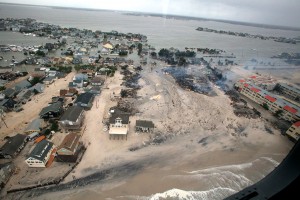New Jersey Future Blog
New Jersey Residents Want More Resiliency Post-Sandy, but at No Cost
June 12th, 2013 by Elaine Clisham
The results of a new survey, previewed at a May 22 conference addressing climate-change preparedness in New Jersey, show that Superstorm Sandy has left a clear majority of the state’s residents acknowledging that the effects of climate change are real, and that there is a need for public policy initiatives at all levels that will help make communities more resilient to future natural disasters.
However, far fewer residents trust government to grasp the implications of climate change and to implement resiliency policies well. And fewer still would be willing to share the costs of implementing those policies.
The survey, conducted by Michael Greenberg of the Edward J. Bloustein School of Planning and Public Policy at Rutgers University, sought to establish whether the events of Superstorm Sandy (and, prior to that, of Hurricane Irene) did anything to make the issue of climate change seem less remote and more real and immediate to New Jersey residents. And indeed that was the case: 70 percent of residents said they were concerned about the impacts of climate change on New Jersey specifically, and 65 percent said recent hurricanes had caused them either to strengthen their beliefs that climate change was real or to reconsider their neutrality on the issue. Almost as many – 64 percent – agreed that the effects of climate change presented tangible risks to them, their family and their friends.
As a result, a majority acknowledged the need for policy changes at various levels to help make communities more resilient to the effects of climate change. Residents strongly (first number) or somewhat (second number) agreed with the following:
- Local governments should be allowed to require housing in some areas to be built in ways that are highly resistant to natural disasters (62.5%, 22.4%)
- The federal or state government should identify areas that should not be developed, so that they can provide natural storm buffers (61.3%, 22.3%)
- Water, sewer, natural gas, road and other critical infrastructure should be relocated away from areas most vulnerable to natural disasters (53.0%, 25.8%)
- Financial incentives should be provided for rebuilding in ways that reduce future risk (49.1%, 30.8%)
- Local governments should be permitted to prohibit residential development in some areas (42.5%, 26.6%)
- The number of times homeowners in high-risk areas may receive federal disaster aid should be limited (38.2%, 21.5%)
- The government should be able to purchase vulnerable properties and turn them into open space (35.0%, 25.8%)
While 64 percent of residents indicated they trust the scientific community on the science of climate change, only 41 percent said they would trust state or local officials to understand the implications of climate change for their communities, and only 49% said that government could be trusted to manage implementation of any policies to increase climate resiliency.
Although most residents agreed with the need for these policy changes, few of them indicated any willingness to help pay for them. Only 19 percent would approve of an increase in the state income tax, even if it were for a limited time, such as five years; 24 percent would agree to a five-year increase in the state sales tax; 42 percent would approve a bond issue to be repaid over 30 years; and only 14 percent would agree to a five-year increase in the gasoline tax. The only funding mechanism that garnered the support of a bare majority – 53 percent – was a temporary additional tax on hotels, motels, airports and recreation facilities. In other words, these new policies are fine as long as someone else pays for them.
This study shows that the people of New Jersey are ready intellectually to embrace the need for hazard mitigation and long-term coastal planning. However, we are not quite sure how to go about it, who should lead it and who should pay for it. There is a critical need right now to help New Jersey residents move through the grieving process, understand clearly the impending hazards, and envision their communities looking and working differently in order to withstand them. Only then will we be willing to identify funding sources and start implementing the on-the-ground changes – changes that will make us all safer, make our economy stronger and save us billions of dollars in the future.


















This article supports a stakeholder driven scenario planning process. When residents, businesses, elected officials and others come together to develop adaptation solutions there is better buy in at the local level.